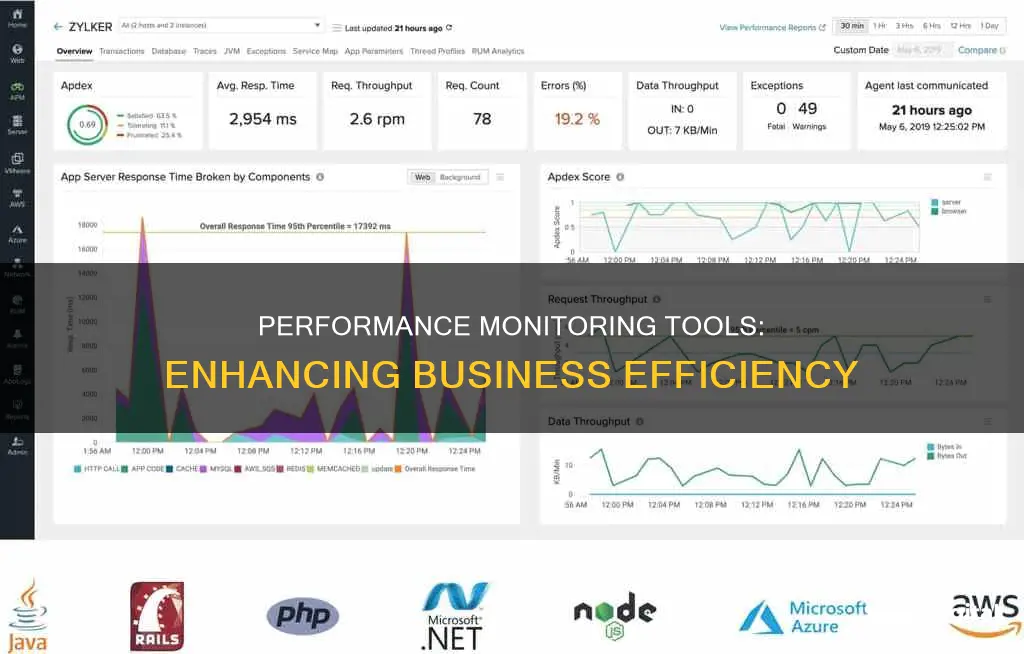
Performance monitoring tools are used to monitor and track the performance of software or web applications to identify and solve any performance issues that may arise. These tools provide performance metrics for applications, with specific insights into statistics such as the number of transactions processed by the application or the response time to process such transactions. They are commonly used by application administrators to manage web applications and discover possible reasons for delays in response time.
Performance monitoring tools are essential to ensure that applications meet the performance, reliability, and user experience required by employees, partners, and customers. They help DevOps teams address performance issues and effectively manage their applications.
Some performance monitoring tools may offer similar functionality to database management systems and network monitoring solutions.
| Characteristics | Values |
|---|---|
| Purpose | To monitor and track the performance of particular software or web applications to identify and solve any performance issues that may arise. |
| Users | Application administrators, developers, IT administrators, DevOps teams, site reliability engineers |
| Metrics | Transactions processed by the application, response time, CPU metrics, memory demands, error rates, transaction tracing, server or application instances, user requests, uptime |
| Visuals | Data visualisations, e.g. dashboards, reports |
| Functionality | Similar to database management systems and network monitoring solutions |
| Use cases | Real user monitoring, synthetic monitoring, agentless monitoring, user-defined transaction profiling, component monitoring, infrastructure monitoring |
| Benefits | Customer satisfaction, reduced operating costs, effective product development, business collaboration |
What You'll Learn
- Application performance monitoring (APM) tools allow users to monitor and track the performance of particular software or web applications
- APM tools help identify and solve any performance issues that may arise
- APM tools provide performance metrics for applications, with specific insights into statistics such as the number of transactions processed by the application
- APM tools assist in remedying any application performance issues
- APM tools are used by IT administrators and developers

Application performance monitoring (APM) tools allow users to monitor and track the performance of particular software or web applications
Application performance monitoring (APM) tools are used to monitor and track the performance of specific software or web applications. They provide performance metrics and insights into statistics such as transaction volumes and response times, allowing users to identify and resolve any performance issues. APM tools are commonly used by application administrators to manage web applications and ensure an optimal user experience.
APM tools are essential for IT teams to ensure that applications meet performance, reliability, and user experience standards. They help identify and address performance issues, manage applications effectively, and ensure optimal application performance.
APM tools provide IT teams, DevOps, and site reliability engineers with real-time data and insights into application performance, enabling them to quickly troubleshoot any issues. They track various metrics, including CPU utilisation, memory demands, disk I/O speeds, application response times, error rates, and transaction tracing.
APM strategies should not only monitor infrastructure and application components but also track business transactions, application dependencies, and user experiences. This comprehensive approach allows DevOps teams to identify the root causes of issues and address them proactively.
When choosing an APM tool, it is important to consider its capabilities, such as full-stack performance monitoring, support for programming languages and platforms, efficient data collection, user experience monitoring, and advanced analytics.
Some popular APM tools include AppDynamics, Datadog, Dynatrace, New Relic, and IBM Instana, each offering unique features and integrations to meet specific needs.
Gamer's Guide to Buying the Perfect Monitor
You may want to see also

APM tools help identify and solve any performance issues that may arise
Application Performance Monitoring (APM) tools are a collection of tools and processes designed to help IT teams ensure that applications meet the performance, reliability, and user experience standards required by employees, partners, and customers. APM tools allow users to monitor and track the performance of particular software or web applications to identify and solve any performance issues that may arise.
APM tools help IT professionals identify the root cause of a problem by providing performance metrics such as transaction speeds, load times, response times, and error rates. This information enables IT teams to quickly pinpoint and troubleshoot application issues, reducing downtime and improving the user experience.
For example, if an application is experiencing slow response times, an APM tool can help identify the root cause of the issue, such as high memory usage or a bottleneck during a memory-intensive process. By identifying the specific cause, IT professionals can then implement targeted solutions to improve the application's performance.
Additionally, APM tools can monitor applications across different environments, including on-premises, cloud-based, and hybrid deployments. This enables DevOps teams to have a comprehensive view of the application and address any issues that may arise in these diverse environments.
Furthermore, APM tools often include features such as synthetic monitoring, which uses behavior scripts to simulate user paths and predict or detect performance issues. Real user monitoring is another feature that allows for the visual monitoring of web applications from the user's perspective, providing insights into regional variability, page load times, and errors.
By utilizing APM tools, IT teams can proactively identify and resolve performance issues, ensuring optimal application performance and an improved user experience.
Removing Monitor Tilt Stand: A Step-by-Step Guide for L197 Models
You may want to see also

APM tools provide performance metrics for applications, with specific insights into statistics such as the number of transactions processed by the application
Application Performance Monitoring (APM) tools are used to monitor the performance of software applications and identify and solve any performance issues. APM tools provide performance metrics for applications, including specific insights into statistics such as the number of transactions processed by the application.
APM tools help IT teams ensure that applications meet performance, reliability, and user experience standards. They do this by tracking various components of performance metrics, such as the performance experienced by the user, including load and response times, and the capacity of computational resources.
APM tools can monitor applications across on-premises, cloud-based, and hybrid environments. They can also monitor the full infrastructure stack, including server and infrastructure metrics, and identify connections between application performance and business outcomes.
By using APM tools, IT professionals can quickly discover, isolate, and solve problems that can negatively affect an application's performance. These tools gather data from specific applications or multiple applications on the same network, including client CPU utilization, memory demands, data throughput, and bandwidth consumption.
APM tools provide real-time performance issue alerts and generate reports with performance analysis data, helping IT teams repair, improve, or update application software. They can also be used to monitor the performance of individual web requests, CPU and memory usage, application errors, and more.
Overall, APM tools are essential for ensuring optimal application performance and providing a seamless user experience.
Monitoring Badges: Where to Buy Them
You may want to see also

APM tools assist in remedying any application performance issues
Application performance monitoring (APM) tools are used to monitor and track the performance of particular software or web applications. They help users identify and solve any performance issues that may arise. APM tools provide performance metrics for applications, with specific insights into statistics such as the number of transactions processed by the application or the response time to process such transactions.
APM tools assist in remedying application performance issues by:
- Providing a baseline for performance metrics: APM tools establish a baseline for performance metrics such as response time and transaction processing speed. They monitor applications for any deviations from this baseline, alerting administrators when performance varies. This helps to identify and address potential issues before they affect end-users.
- Visualising data: APM tools display performance metrics in various data visualisations, such as dashboards and reports. This makes it easier for users to understand the data and identify any issues.
- Root cause analysis: By providing detailed performance data, APM tools help users identify the root cause of performance issues. This enables faster and more effective remediation.
- End-to-end visibility: APM solutions can track full transactions, regardless of where application components are hosted. This allows users to monitor applications across different environments, including on-premises, cloud-based, and hybrid deployments.
- Real-user monitoring: This feature allows users to monitor applications from the perspective of the end-user, gaining insights into regional variability, page load times, response times, and errors.
- Synthetic monitoring: This approach uses behaviour scripts to simulate user paths and predict or detect performance issues.
- Comprehensive tracking: APM tools can follow applications across all layers of the application stack, including code and transaction levels. This enables users to identify and address issues impacting performance.
- Alerting: APM tools provide immediate alerts when performance dips below established baselines, allowing for prompt remediation.
Ankle Monitoring: Does Time Served Count in Court?
You may want to see also

APM tools are used by IT administrators and developers
Application Performance Monitoring (APM) tools are used by IT administrators and developers to monitor the performance of software applications and ensure they are delivering a quality user experience. APM tools help identify and fix any performance issues, such as slowdowns or bottlenecks, that could impact the user experience.
IT administrators use APM tools to monitor their company's applications and ensure overall system health and performance. By using APM tools, administrators can identify and address performance issues as they arise, maintaining a consistent level of service for users. APM tools provide real-time alerts and generate reports on performance analysis, enabling IT teams to repair, improve, or update application software.
Developers use APM tools to monitor the performance of their developed applications and ensure a consistent, quality user experience. APM tools allow developers to understand the impact of new code on the complete application and address any scalability issues, design bottlenecks, or other problems. By using APM tools, developers can often identify issues before the code reaches the quality assurance (QA) stage, reducing the number of bugs and code changes required after deployment.
Both IT administrators and developers benefit from the data and insights provided by APM tools, which help them collaborate and ensure optimal application performance. APM tools provide visibility into application performance, including metrics such as transaction speeds, response times, resource utilization, and error rates. This information enables IT professionals and developers to proactively address performance issues and improve the user experience.
Does Multiple Monitor Setup Slow Down Your CPU?
You may want to see also
Frequently asked questions
Performance monitoring tools are software solutions that allow users to monitor and track the performance of particular software or web applications. They provide performance metrics and help identify and solve any performance issues.
Performance monitoring tools help ensure optimal user experience by identifying and fixing performance issues. They also assist in reducing operating costs by optimising resource allocation and improving product development through early bug detection.
Performance monitoring tools track various metrics such as CPU usage, memory demands, response times, error rates, transaction tracing, server instances, user requests, and uptime.
Some popular performance monitoring tools include New Relic, AppDynamics, Datadog, Dynatrace, and Stackify.







